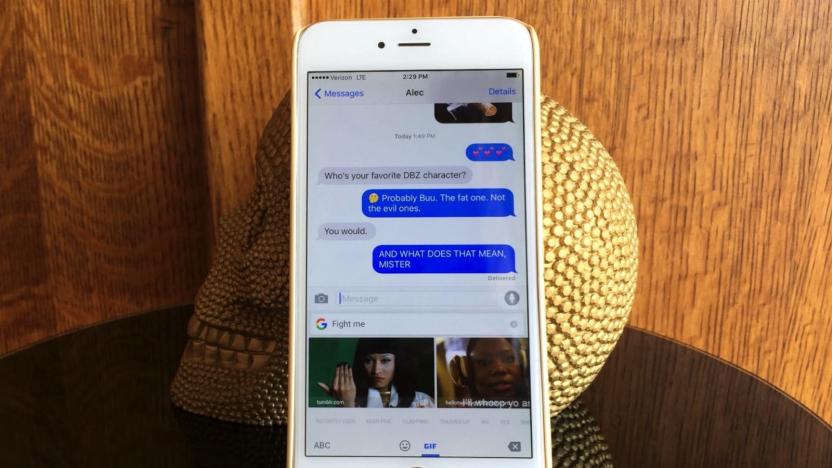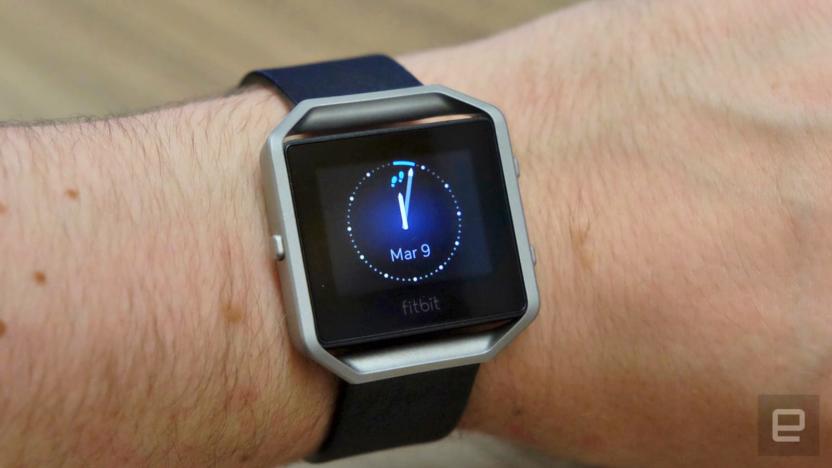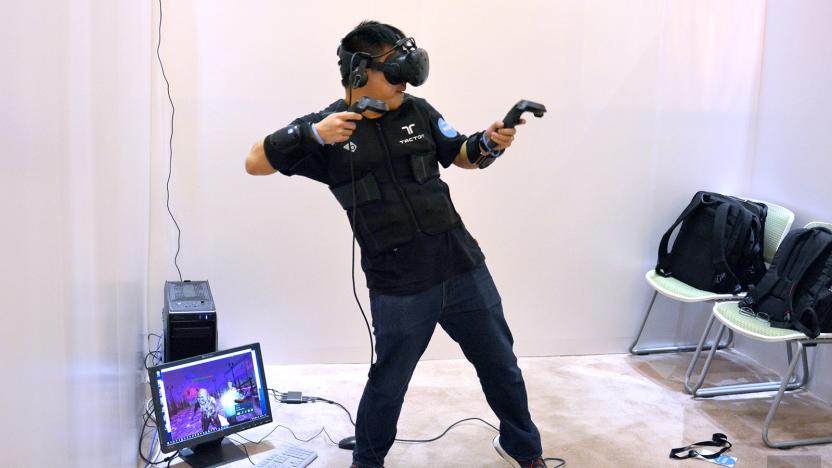hapticfeedback
Latest

Google adds haptic feedback to its iPhone keyboard
Haptic feedback has been a feature in iPhones for the past few years, but you wouldn't know it while you were typing -- even third-party keyboards either use it in limited situations (like SwiftKey) or ask you to pay up. Google is willing to step up to the plate with a full and free solution, though. The latest version (1.40) of Gboard for iOS has introduced an option for haptic feedback with key presses, giving you reassuring thumps as your fingers hit the glass. You can't fine-tune the vibration strength like you can with Android, but that tactile experience will be there.

Fitbit faces ill-timed lawsuits over haptic feedback
Fitbit is facing hard times between slowing fitness tracker sales and a reportedly floundering smartwatch project. Unfortunately, there's more bad news to add to the pile. Immersion is suing Fitbit in China and the US for allegedly violating multiple patents (three in each country) for haptic feedback. Supposedly, devices ranging from the original Flex to the Blaze all borrow Immersion's approach to vibrating a device in response to commands and for alerts. Fitbit rebuffed "numerous attempts" to strike a licensing deal, Immersion claims, so this is considered a last resort.

bHaptics' TactSuit is VR haptic feedback done right
Every now and then, we come across a new attempt to bring haptic feedback to VR, but we've yet to see one that's fully convincing; those that are still around tend to be both pricey and far from ready for the market. Well, this is apparently no longer the case thanks to bHaptics. At HTC Vive X demo day in Shanghai, I got some hands-on time with this Korean startup's TactSuit, a wireless kit consisting of a haptic mask (which is a rarity), two haptic sleeves and a haptic vest. The fascinating part here is that it comes with a total of 87 feedback points, which is a lot more generous than what the other suits offer. It'll also cost less than its direct competitor, Nullspace VR's $549 Hardlight suit which only has 16 feedback points.

A haptic wristband could help the blind 'see' the world
Technology to help the blind navigate usually focuses on replacing the sight they're missing or by adding auditory cues to an already cluttered soundscape. But for many sight-impaired individuals, the sense they rely on most is one that tends to be ignored by a lot of tech-based solutions: touch. It's a subtle way to convey a lot of information, and the design company WearWorks is looking to take advantage of this with its new haptic wristband, guiding people around via simple vibrational cues.

Nintendo's HD Rumble will be the best unused Switch feature of 2017
If I had to describe Nintendo in just three words, I'd steal the shared city slogan of Austin, Santa Cruz and Portland: "Keep Nintendo Weird." The Japanese game giant delights in its unique character and has made a habit of defying convention. Nintendo's gimmicks are always fascinating, but they don't usually work out. The Wii Remote's speakers largely went unused. Most third-party developers failed to take advantage of the Wii U touchscreen. So what's Nintendo Switch's soon-to-be-overlooked innovation? A haptic feedback system called HD Rumble.

Meet the VR boots that want to make you feel every step
If 2016 was the year of virtual reality, 2017 might just be the era of VR accessories. Japanese gadget-maker Cerevo has debuted Taclim, a pair of motion controllers and shoes that provide haptic feedback in VR, vibrating in various ways as players walk across different surfaces or kick enemies in the face.

PhD student uses a robot to make VR feel more real
Between the HTC Vive and the Oculus Rift, we've come a long way towards being able to step in to virtual worlds -- but touching those false realities is a different matter. Solving this means finding a haptic technology that can adapt to needs of a constantly changing virtual environment. One PhD student's solution? Use a robot arm.

Disney's remote control robots move just like people
Imagine walking into a Disney theme park and being greeted by Mike from Monsters Inc. A life-size Mike, perfectly spherically-proportioned on those spindly legs. Fitting a human into a costume like that is impossible. That's why Disney Research is building a new kind of haptic-feedback remote control system which will allow us to control robots as easily as we move ourselves.

Flexible smartphones may be coming sooner than you think
Companies have been promising us futuristic, paper-like displays since forever, but so far we remain unimpressed. The ReFlex, a prototype flexible smartphone from Queens University is tantalizingly close to what we've been waiting for, though. To build it, the team mated a 720p flexible LG OLED display to bend sensors and haptic feedback motors. Powering the device is an Android 4.4-powered board, complete with custom drivers, placed in the non-flexible part beside the display.

Teslasuit does full-body haptic feedback for VR
Smartphone-powered headsets like Google Cardboard and Samsung's Gear VR have been worthy stop-gaps for introducing the medium of modern virtual reality. But this year, more resource-intensive VR experiences, games especially, will finally make it into consumers' homes. Pre-orders for the final Oculus Rift opened today, and competitors like Playstation VR and HTC's Vive aren't too far behind. For start-up Tesla Studios, though, pulling on a headset and grabbing a controller just doesn't seem immersive enough. That's why it's developing the Teslasuit, a full-body haptic feedback ensemble for putting you well and truly in the game.

ICYMI: Buzzing blind guide, lab-grown voice and more
#fivemin-widget-blogsmith-image-25001{display:none;} .cke_show_borders #fivemin-widget-blogsmith-image-25001, #postcontentcontainer #fivemin-widget-blogsmith-image-25001{width:570px;display:block;} try{document.getElementById("fivemin-widget-blogsmith-image-25001").style.display="none";}catch(e){}Today on In Case You Missed It: Doctor's used bioengineering to grow fresh vocal cords that they say sound just like the real thing. Haptic feedback headbands are helping to guide sight-disabled people with buzzing when an obstacle is present. And a collaborative synthesizer from London lets four people control a device, jamming out electronically, together.

ISS astronaut will get to drive and 'feel' a rover on Earth
It's going to be a little while before humanity sets foot on Mars, but in the meantime NASA has a bundle of robots exploring the planet for us. The data they're collecting is valuable, but now researchers want to give their operators greater control. Specifically, they're interested in force feedback -- timely vibrations that would help astronauts carry out difficult tasks remotely. The European Space Agency (ESA) has developed a new rover with this in mind -- the "Interact Centaur," which has an onboard camera and two force-sensitive arms. ESA astronaut Andreas Mogensen is headed to the International Space Station (ISS) on September 2nd and, five days later, he'll be controlling one that's back on Earth.

Your Apple Watch is late because of bad haptic feedback parts
Wondering why your Apple Watch won't ship for weeks, even though you ordered as soon as humanly possible? The Wall Street Journal might know why. Its sources claim that some Taptic Engines (the haptic feedback unit that vibrates your wrist) broke down in early testing, prompting Cupertino to switch suppliers and create a massive-but-necessary logistical headache. From all indications, Apple is pushing many orders to June simply because it expects to get up to speed by then. That won't be much consolation if you're staring at a bare arm for the next month or more, but you'll at least know why you're missing out. [Image credit: iFixit]

iFixit explains how Apple's new MacBook haptic trackpad works
Apple's new range of MacBooks have something particularly new inside them: the Force Touch trackpad. No longer hinged like previous Apple laptops, the new touchpad houses a "Haptic Engine", outputting tactile feedback that will let you "feel" what's happening on-screen. iFixit's taken a closer look at how Apple did it, and while the trackpad is no longer hinged, there are now four spring mounts underneath. That haptic engine? A load of wires coiled around a magnetic core, which makes that all important vibrational feedback.

This pocket-sized gesture controller aims to replace your mouse
If a new Indiegogo project has its way, you could soon be waving goodbye to that old, beloved mouse of yours. Meet Flow, a small gadget that pairs with your desktop or laptop and can be programmed with shortcuts to your most frequently used actions. At launch, Flow is said to offer support for more than 30 applications, including popular ones like Final Cut Pro X, Photoshop, Premiere, SoundCloud, Spotify and YouTube. With Spotify, for example, you could set up Flow to skip tracks by simply making a swipe gesture over the device, among other things. Right now, most of Flow's information points to the peripheral being used with desktops or laptops, but the company does note that there could be support for mobile applications in the future. The Flow Indiegogo page appears to be doing really well thus far, so be sure to check out the crowdfunding page if you want to see this get made.

Home-made vibrating gloves train your finger muscles to touch type (video)
You know what can teach you Braille and piano a lot more quickly than traditional means? Vibrating gloves, or gloves with haptic feedback, if you will. In fact, IEEE Spectrum senior editor David Schneider was so intrigued by the idea, that he put together his own version to serve as a haptic touch-typing tutor for his 11-year-old son. He admits that his gloves (made using transistors, $14 worth of vibration motors purchased from eBay and long cords connecting them to an Arduino Nano board) aren't as sleek as Georgia Tech's piano-teaching ones. But, hey, they worked, and once he created a program to go along with them, they did their job well enough.

Researchers laugh in the face of flatness with new approaches to haptic displays (video)
If the future of haptic technology is your jam, then the symposium on User Interface Systems and Technology at the University of St. Andrews is the place to be this week. Teams from Disney Research and the University of Bristol will present two different approaches to adding 3D tactility to touch technology, and the results are pretty fascinating. While incorporating haptic feedback into displays isn't unheard of, adapting it to live content has been a challenge. At Disney, researchers developed an algorithm that can translate information culled from depth maps of virtual surfaces into dynamic tactile experiences. Through the magic of electrovibrations, the team was able to simulate changes in texture as a finger slid across a flat surface displaying both static imagery and live video. The group from Bristol opted for a different strategy; instead of vibrations produced by electricity, their UltraHaptics system relies on ultrasound speakers embedded behind a display used in conjunction with a Leap Motion controller. Basically, high-frequency sound waves produce an invisible field that creates a sensation of texture without the user having to touch the screen at all. Interest piqued? Check out videos of both systems in action after the break.

Google settles patent lawsuit from Immersion over Motorola use of haptic feedback
Immersion is known for guarding its haptic feedback patents with enthusiasm -- just ask Microsoft, among others. Motorola learned first-hand when Immersion sued over the use of basic haptic technology in May, but all that's water under the bridge now that Motorola's new parent Google is settling the matter out of court. While the exact sums aren't public, Google will pay Immersion to address any relevant past shipments, license the patents for future Motorola shipments and take care of "certain issues" with Google-badged hardware using the disputed vibration techniques. Immersion's end of the bargain is simply to end its legal action, including an ITC complaint, although the company makes clear that non-Motorola Android phones aren't covered by the deal. We're sure Google isn't happy to shoulder additional costs on top of its $12.5 billion Motorola acquisition, although it may see the settlement as a matter of establishing focus. After all, there's bigger fish to fry.

Sony tries to patent stylus with friction-based haptic feedback
There's a certain disconnected feeling that comes with using a touchscreen, and Sony isn't content with vibration being the sole standard for haptic feedback. The company has filed a bunch of patent applications for a stylus which instead uses artificially generated friction to make it harder or easier to move across the screen. It works using a "rolling contact ball gripping mechanism," which responds to instructions from the phone or tablet and employs actuators to increase or decrease friction on the roller ball tip. The various filings outline some potential benefits of this stylus-based haptic feedback, including being able to feel yourself "carving and molding" 3D objects in a design application, or understanding your character is "fatigued or damaged" while playing a game. We know that Samsung increased the friction of the Note II's S-Pen to make it feel more like writing on paper, but Sony's approach would potentially bring a whole new layer of interaction.

ForcePhone from Nokia Research, HIIT sends positive vibes with a squeeze
Most device vibration technology is used as pure feedback -- either confirmation that you've pressed something or that you've come across an obstacle. If a prototype developed by Nokia Research and the Helsinki Institute of Information Technology ever translates to production, however, it'll be as much a part of personal phone conversations as a soft voice or a cheeky text message. The modified N900 attaches a resistor that responds to a squeeze at four different pressure levels, and doles that out during a traditional or Skype-based call as a vibration on the other end. As you'd imagine, the aim is to give family, friends and lovers the closest they'll get to a hug (or the occasional frustration) when the distance is just too great for an in-person visit. Don't hold your breath for an extra-lovable Lumia anytime soon: there's no mention of any near-term production plans, and any adoption would require a platform switch just to get started. But if we ever see "reach out and touch someone" become a lot more than a slogan, we'll know where it came from.













